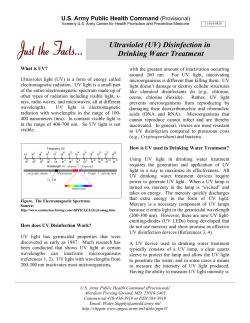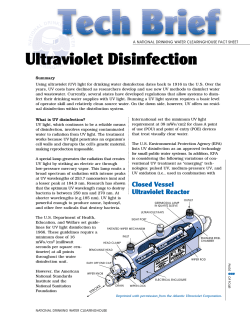
Treatment Options
• This process may use and discharge significant amounts of salt; however, sodium-free softeners are available. • They are inexpensive and easy to install and require no power to operate. These are not disinfection devices and should only be used on water that is already disinfected and safe to drink. • Backwash from softener should not be discharged into private sewage disposal system (septic tanks). • If you are using these devices for water conditioning, you should know that: Where can I find additional information? yy The bacterial levels in your drinking water may increase because of the dirt and organic material that are trapped in the filters; and Please remember… yy If you use these devices for the removal of Cryptosporidium oocysts and Giardia cysts, you must use only those filters that will remove particles one micrometre or less in diameter. This fact sheet is only a summary of your responsibilities as the owner or operator of a SDWS and is not a substitute for legal advice. For a more complete understanding of your legal responsibilities as an owner or operator, refer to Ontario Regulation 318/08 and Ontario Regulation 319/08 or any directives issued on your system. b) Reverse Osmosis • This device conditions your SDWS supply by forcing water through a filtering membrane to remove most microbiological (bacteria, viruses and protozoa) and chemical (metals and minerals salts) parameters. In addition, you should become familiar with the procedure documents produced to help you efficiently operate a SDWS: • It is easy to install and maintain; however, the water must be pretreated to increase the life of the membrane filters that may clog or rupture if the water is of poor quality. • Procedure for Disinfection of Drinking Water in Ontario; and • Procedure for Corrective Action for Small Drinking Water Systems that are Not Currently Using Chlorine. c) Water Softener • This process is used to remove inorganic contaminants that are inadequately removed by filtration or sedimentation. It is also used to treat hard water and can be used to remove arsenic, chromium, excess fluoride, nitrates, radium and uranium. For general information about well water safety, ask your health unit staff for a copy of: You may also find additional information on the following Ontario ministry websites: Drinking Water Systems under the Health Protection and Promotion Act Treatment Options Acts and Regulations: www.e-laws.gov.on.ca/index.html Working Together to Safeguard our Health • Ontario Regulation 318/08: www.e-laws.gov. on.ca/html/regs/english/ elaws_regs_080318_e.htm What are the treatment requirements for my small drinking water system (SDWS)? • Ontario Regulation 319/08: www.e-laws.gov. on.ca/html/regs/english/ elaws_regs_080319_e.htm Did you know that as of December 1, 2008, the Ministry of Health and Long-Term Care (MOHLTC) has oversight of small drinking water systems (SDWS) in Ontario? The MOHLTC has prepared an information kit to help you become familiar with the changes to Ontario’s drinking water legislation. Reading the poster How to Ensure your Water is Safe is a good beginning. Ministry of Health and Long-Term Care (MOHLTC): www.health.gov.on.ca • SDWS Program: www.ontario.ca/ Health-Drinkingwater • Current list of local public health units: www.health.gov.on.ca/healthunits Ministry of the Environment (MOE): www.ene.gov.on.ca/en/index.php • Current list of licensed laboratories: www.ene.gov.on.ca/en/water/sdwa/ licensedlabs.php. Ministry of Agriculture, Food and Rural Affairs (OMAFRA): www.omafra.gov.on.ca/english/ How can you stay up-to-date on drinking water issues? Catalogue No. CIB-2155978 35 M © Queen’s Printer for Ontario, March 2009 • Softened water is not recommended for drinking because increased sodium content can pose health risks if exceeding the upper limit of 20 mg/L. the quality of the source water used by your SDWS, e.g., if the water is dirty or has sediment plugging the filter, you will need to frequently change the cartridge filters. You can request that you be added to the mailing list to stay current on small drinking water systems by sending an email to: environmental.health@ontario.ca • Keeping Your Well Water Safe to Drink: An information kit to help you care for your well. 5 6 Under the Health Protection and Promotion Act, Ontario Regulation 318/08 (Transitional – Small Drinking Water Systems) and Ontario Regulation 319/08 (Small Drinking Water Systems) as an owner or operator of a SDWS, require you to provide users with safe drinking water at all times and to know your responsibilities for the type of system that you operate. A public health inspector (PHI) will conduct a site-specific risk assessment and issue a “directive” for each SDWS. A “directive” outlines operational requirements that must be carried out by the owner or operator. The type of source water you use and the design of your SDWS will be important considerations in determining your operational requirements, including any treatment devices that are necessary for providing safe drinking water to users at all times. To know if you require a treatment device for your SDWS, you should begin with regular testing of your drinking water for E.coli and total coliforms. Testing must be carried out by an Ontario laboratory that is licensed by the Ministry of the Environment (MOE) or an out-of-province laboratory that has been approved by the MOE. Contact your local public health unit to discuss your specific circumstances and schedule a sitespecific risk assessment. Do you know the quality of your source water? In Ontario, most SDWS operators obtain their water from two main sources, groundwater or surface water. The type and quality of source water used and the design of your SDWS usually determines the treatment required: Secure Groundwater: Treatment may not be required for water that is obtained from a secure, well-constructed and maintained groundwater source, such as a drilled well. Non-secure groundwater: Treatment is required if the source water supplying your SDWS is a non-secure groundwater source, and is used for drinking. If the construction or design of your well allows contamination by surface water, then you may be required to provide filtration and disinfection to the well. Surface water: Treatment must be provided if the source water supplying your SDWS is from a surface water source and is used for drinking. For surface water, you will be required to provide mechanical or chemicalassisted filtration and primary disinfection. If your SDWS has a distribution system, you may be required to provide secondary disinfection. To help you make the right choices about the treatment requirements that are appropriate for your SDWS, contact the local public health unit and speak to a public health inspector. Following the site-specific risk assessment, the inspector will issue you a directive which will set out any treatment requirements for operating your SDWS. Contaminant Choose a treatment device that is best for your drinking water system There are two types of drinking water treatment devices available: disinfecting devices that are used to inactivate or remove harmful microorganisms, and water conditioning devices that are used for the control or removal of chemical, taste and odour problems. Before you choose a device, it is important to have your water tested and speak with a water treatment specialist. Look for a device that has been certified by an accredited certification body. They provide standards that have been designed to safeguard drinking water by helping to ensure the material safety and performance of products that come into contact with drinking water. Possible removal technologies Turbidity (suspended material, dirt) Filtration Fecal coliform (coliforms and E. coli) Disinfection Viruses (Enteroviruses) Filtration and disinfection Parasites (Cryptosporidium oocysts and Giardia cysts) Filtration and disinfection Chemicals (Arsenic, Fluoride, Lead, Nitrate and Nitrite, Sodium, Uranium) Contact a water treatment specialist to determine which device would be most suitable for your system Submicron Filtration, Anion Ion Exchange, Activated Alumina, Reverse Osmosis, Micro-filtration Remember, these steps are a simplification of water treatment. To find additional information on treatment devices, please refer to the MOE website at www.ene.gov.on.ca Filtration • This process uses a filter to remove particulates and reduce the number of parasites from the source water. Filtration is required for all surface water systems and for non-secure groundwater systems that are vulnerable to surface water contamination. There are two main processes that are used to adequately treat your SDWS supply, filtration and disinfection. The following table is a guide for choosing the most appropriate treatment device. It is based on the premise that it is practical and efficient to treat some water quality problems before others. For example, you must control turbidity, acidity, hardness or iron before water conditioners such as activated carbon filters, reverse osmosis units, or distillers can operate efficiently. • Filtration is the simplest method for removing suspended particles and turbidity from a drinking water supply to allow for successful disinfection. Filtration methods include slow and rapid sand filtration, diatomaceous earth filtration, direct filtration, membrane filtration, and cartridge filtration. 2 Disinfection source – UV radiation. The special light is immersed in the water in a protective transparent sleeve and emits UV waves that can destroy harmful micro-organisms. This type of treatment is highly favoured since it does not require the addition of chemicals and therefore leaves no disinfection by-products. UV devices are required to have an alarm or automatic shut-off to alert when there is a failure. • This process reduces or eliminates the number of harmful micro-organisms in water. Disinfection is required for all surface water systems and for non-secure groundwater systems that are vulnerable to surface water contamination; • Disinfection can be achieved by means of chemical or physical disinfectants such as chlorine, chlorine dioxide, ozone, and ultraviolet (UV) light. The most common disinfectants used to treat water for small systems are chlorine and UV light. • The UV device works by emitting similar UV radiation to the sun. This radiation alters the genetic material of viruses, bacteria, molds or parasites so that they cannot reproduce and are considered inactivated. UV treatment does not alter the water chemically as nothing is added except energy. UV treatment does not remove dirt particles, metals such as lead or iron, or hard minerals such as calcium. Other devices are required to remove particles, metals and minerals. There are two types of treatment systems commonly used to treat your SDWS supply: point-of-entry or point-of-use. Point-of-entry • This device is installed where the water enters the home or building. All water used within the home or building will be treated, including water used for bathing and laundry. • UV devices are not effective at treating water that is highly contaminated, heavily cloudy or turbid, or high in iron. To increase the effectiveness of the UV device, the water may have to be pretreated. UV lamps should be checked and cleaned periodically, or replaced where necessary in accordance with the manufacturer’s instructions. • Point-of-entry systems tend to be larger and more expensive than alternative systems. Point-of-use • This device is installed at the tap where the water is being used for drinking or cooking. Only water used from this tap is treated. Disinfection and water conditioning devices for treating your SDWS • Water from all other taps will be untreated and should not be used for drinking purposes. 2. Chlorinators • Chlorination devices provide disinfection to a system by continuously adding a chlorinated product to all water that is drawn from the system. Specific examples of treatment systems are outlined below: 1. Ultraviolet (UV) Light • Treatment is provided by thoroughly mixing all water in the system with a specific amount (concentration) of chlorine for a sufficient (contact) time period. • Ultraviolet treatment is the disinfection process of passing water by a special light 3 3. Ozonators • The time that is required for disinfection depends on the concentration of the chlorine solution, the quality of the water entering the system, the pH of the water, the temperature and the discharge rate of the pump. • These devices use ozone to inactivate micro-organisms and provide some residual protection. • Disinfection of most disease-causing microbes occurs after 20 minutes of contact time if the pH is between 6 and 8 and the free residual chlorine is in the range of 0.2 mg/L to 0.4 mg/L. • The device is sealed and requires moderate amounts of electricity to produce ozone. Caution must be used to prevent the leakage of excess ozone from the unit into environment. • Frequent monitoring of the water chemistry is necessary to ensure that adequate disinfection is being continuously provided. • Although these devices are easy to install and maintain, they can be expensive. 4. Other Treatment Devices (including devices used for removal of chemicals, taste, odour) Note: There may be an after-taste produced by the disinfection process. To effectively remove these disinfectant by-products, activated carbon filtration or reverse osmosis devices (discussed below) may be used. Chlorine UV light Advantages • Provides disinfection residual • Provides continuous disinfection and • Allows for easy monitoring Advantages • Simple to operate • Does not require the addition of chemicals • Requires very little contact time (seconds versus minutes for chemical disinfection) Disadvantages • Requires a constant supply of chemicals • Requires a longer contact time (minutes versus seconds for UV light) Disadvantages • No disinfection residual provided • No continuous protection provided and • If the drinking water system has a distribution system, secondary disinfection will be required 4 These include ceramic filters, chlorine or iodine tablets, special cups or straws along with other filters supplemented with a chemical disinfectant. These devices must be used in accordance with the manufacturer’s instructions. • The appearance, taste and smell of drinking water are usually more obvious to the consumer than the bacterial quality. Chemicals such as iron, manganese, sulphide and calcium hardness can cause odour and taste problems. • There are several devices available to remedy these problems; however, these units deal mainly with poor odour and taste problems and do not provide disinfection. If not used correctly, they may even increase existing problems with bacterial contamination in some circumstances. a) Activated carbon or charcoal filters • These devices are used to remove chlorine, odour and taste caused by organic materials. The efficiency of the device depends on
© Copyright 2025












